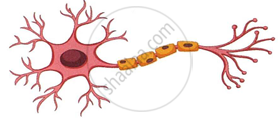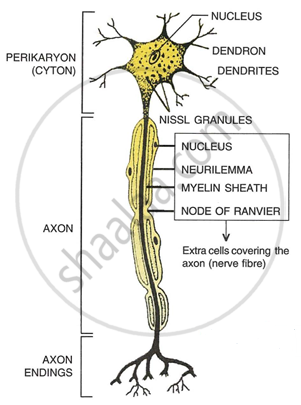Advertisements
Advertisements
प्रश्न
The figure given below is the basic structural and functional unit of the human nervous system. Study the diagram and answer the following questions:
 |
- Write the technical term for the diagram.
- Name two organs of our nervous system where these cells are richly found.
- How are these cells significant for us?
- Name the cell organelle that is absent in these cells and how does it affect our body metabolism?
- Redraw the same figure and label the following Perikaryon, Axon, Dendrites, Myelin sheath and Node of Ranvier.
उत्तर
- Nerve cell, or Neuron.
- Brain and spinal cord.
- Neurons are vital components of the neurological system. They are essential for processing information, regulating movement, seeing our surroundings, and facilitating learning and memory.
- It contains all the cells. Nerve cells cannot divide, resulting in the absence of the centrosome.

संबंधित प्रश्न
The number of Spinal nerves in a human being are :
(A) 31 pairs
(B) 10 pairs
(C) 21 pairs
(D) 30 pairs
Describe three kinds of nerves, giving the example of each.
Define the following:
Axon
Write whether the following is true or false:
Neurotransmitters are released on activation.
Write whether the following is true or false:
Neurotransmitters are either broken down or reabsorbed after they have conducted an impulse.
Draw a labeled diagram of a myelinated neuron.
The neurons which carry impulse from the central nervous system to the muscle fibre.
Impulses travels rapidly in ______ neurons.
Our body contains a large number of cells ‘L’ which are the longest cells in the body. L has long and short branches called ‘M’ and ‘N’ respectively. There is a gap ‘O’ between two ‘L’ cells, through which nerve impulse transfer by the release of chemical substance ‘P’.
(i) Name the cells L?
(ii) What are M and N?
(iii) What is the gap O?
(iv) Name the chemical substance P?
Note the relationship between the first two words and suggest the suitable word/words for the fourth place.
Axons : Nerve :: Cytons : ______.
